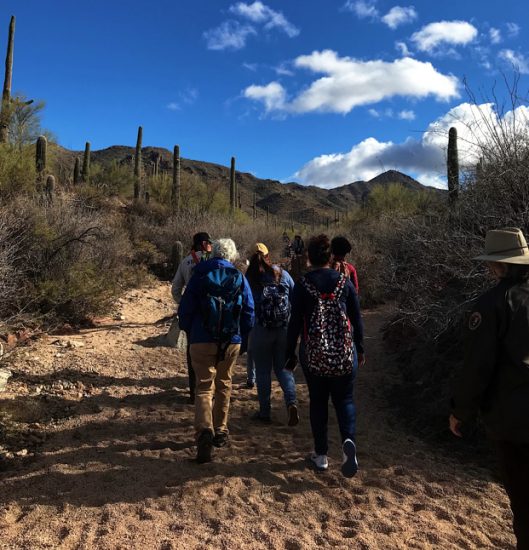By Getsemani Cazares
On Monday, Feb. 19, Pueblo teacher Ms. Elizabeth Raizk escorted her juniors and seniors in her advanced placement environment science class on a field trip to nearby Saguaro National Park (West) to study our desert’s indigenous cacti.
On this trip, approximately 15 miles west of Pueblo High School, students studied different sizes of saguaros—as well as to measure their heights and temperatures. Students even studied bird holes in these saguaros.
Raizk said, “There were four groups of six students, and each group’s job was to study a different plot, each with five saguaros.”
Students were required to hike to find their “assigned” saguaros, so they used a GPS and a photo log, which were helpful resources to these students.
Raizk said, “My students and I were outside for two hours, so after all of the hiking, we spent some time at the Visitors Center to eat lunch.”
Senior Maria Servellon attended the field trip, and she expressed that this event ended up being a “blessing”.
“[Before the trip] I was totally stressed—about grades, tests and deadlines,” Servellon said, “so this field trip was definitely an outlet for me.”
She added, “At first, however, I thought this would be just an average hiking trip through a land of cactus. However, my peers and I had an opportunity to conduct annual saguaro surveys and observed how certain cacti grow over time and how they measure environmental impacts. I learned that saguaros are great indicators of weather patterns and water patterns.”
Senior Marco Madrigal also attended the field trip.
“I very much enjoyed the experiences about this field trip—especially how to measure saguaros and learn that the desert is an integral part of where we live,” Madrigal said. “We definitely learn a lot more when we actually get to experience learning instead of reading about saguaros out of textbooks. I’ll never forget everything I learned on this field trip.”
Saguaro National Park (West) boasts many visitors, Raizk said, but not many native students, which Raizk think is “a shame” because the Park is the “grand symbol” of the Sonoran Desert.
Saguaros should be respected by all, Raizk said, and they are especially culturally important to the Tohono O’odham Nation. These Native Americans harvest ripe saguaro fruit in the spring to make wines, jams, and jellies. Saguaro wine is ritually consumed during Nawait I’i, a Tohono O’odham rain ceremony.
Few people know that saguaros are the largest of all cactus species in the United States and can grow to more than 40 feet tall and can weigh more than a ton! Saguaros can also live to be between 100 and 200 years old. Some saguaros can grow as many as 25 “arms”; some grow none.
On March 1, 1933, in the last days of his presidency, Herbert Hoover signed a proclamation that established the Saguaro National Monument, which was considered a victory for both botanists and boosters in Arizona who had worked for years to protect this species. Most importantly, in 1961, at the urging of the people of Tucson and Secretary of Interior Stewart Udall, President John F. Kennedy added 25 square miles of splendid cactus lands in the Tucson Mountains to the Monument.
Finally, after setting aside vast areas as wilderness, Congress elevated Saguaro to “National Park” status in 1994.
Raizk said, “The desert is a piece of all of us.”
